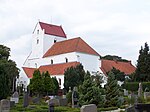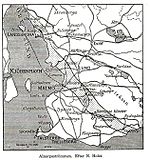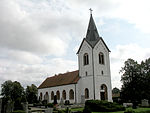Dalby Church (Swedish: Dalby kyrka), sometimes also called the Church of the Holy Cross in Dalby (Heligkorskyrkan i Dalby) is a church in Dalby, Lund Municipality in the Swedish province of Scania. It is one of the oldest churches in Sweden. When it was built Dalby was part of Denmark, and the church was commissioned by King Sweyn II of Denmark. It was constructed during the second half of the 11th century. For six years, it served as the seat of a bishop, before the diocese was merged with the Diocese of Lund nearby. The church was built with inspiration from Hildesheim Cathedral, and masons from Hildesheim appear to have worked on its construction site.
Archaeological excavations have revealed the remains of buildings west of the church, which some researchers have interpreted as the remains of a royal palace connected to the church, or possibly some kind of ecclesiastical compound. The church was enlarged during the 12th century, and a community of canons serving it eventually developed into a full monastery. In the 13th century, new buildings were built for the monastery. Some of these are partially preserved north of the church. Following the Reformation and the dissolution of the monastery in 1541, the church suffered neglect and dilapidation: in 1686 the apse was demolished and in the 1750s the east part collapsed. Since the late 19th century, the church has been extensively investigated by archaeologists and restored.
The building consists of a nave, a south aisle and a west tower. Less than half of the original building has been preserved. The entrance is through a church porch added in the 13th century. Inside, the church is whitewashed (as is the facade) with the exception of those walls which remain from the first church. An unusual element is the westernmost south pillar of the nave which contains a niche in which a smaller column has been inserted. It is probably a symbolic representation of Boaz and Jachin, two pillars from Solomon's Temple. The crypt is very similar to the crypt of Lund Cathedral, and has four decorated pillars supporting its groin vaults. The church contains a decorated baptismal font from the 12th century, medieval wooden sculptures, a pulpit from 1705 and an altarpiece from the middle of the 18th century. It belongs to the Church of Sweden and lies within the Diocese of Lund.










